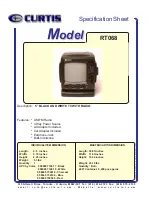
10
Step 2 - Add Gasoline or Connect Propane Tank
To add gasoline:
To ensure that this generator runs smoothly, use only FRESH, UNLEADED GASOLINE WITH AN OCTANE RATING OF 87 OR HIGHER. Unleaded
gasoline produces fewer engine and spark plug deposits and extends the life of the exhaust system.
1.
Be sure that the generator is on a level surface.
2.
Unscrew fuel tank cap and set aside. (NOTE: The fuel tank cap may be tight and difficult to unscrew.)
3.
Slowly add fresh, unleaded gasoline (with an octane rating 87 or higher) to the fuel tank. Be careful not to fill the fuel tank above the upper limit
line.
NOTE
: Because gasoline can expand, do not fill the fuel tank to the very top.
4.
Securely tighten the fuel tank cap and immediately wipe up any spilled gasoline with a dry cloth.
Fuel Tank Capacity (gallons)
1.2
Fuel Type
Fresh, Unleaded Gasoline Octane Rating 87 or Higher
IMPORTANT:
•
Use UNLEADED gasoline with an octane rating 87 or higher.
•
NEVER use a mixture of oil and gasoline.
•
NEVER use old and /or contaminated gasoline.
•
Avoid getting dirt and /or water in the fuel tank.
•
Gasoline can get aged and oxidative deterioration in the fuel tank , which makes generator starting difficult. Never store the generator
with fuel for extended time (over one month).
To connect propane:
If using LPG / Propane, first connect the regulator , which was included with the generator, to the Propane Tank, then connect the other end to the
Gas Inlet. Make sure the LPG/Propane cylinder is vertical and securely positioned.
Step 3 - Ground the Generator
Ground this generator by tightening the grounding nut against a grounding wire as illustrated in Figure 3. Use a No. 12 AWG (American Wire Gauge)
stranded copper wire which is generally considered an acceptable grounding wire. The other end of this grounding wire should be connected to a
copper or brass grounding rod that is driven into the earth. Proper grounding
of the generator will help prevent electrical shock in the event of a ground fault
condition in the generator or in connected electrical devices.
Proper grounding also helps dissipate static electricity, which often builds
up in ungrounded devices.
Grounding codes can vary by location. Contact a local electrician
for information on grounding regulations for your area.
Failure to properly ground this generator can result in electrocution.
Figure 3
The Grounding Terminal
is located on the front of
the generator, to the
right of the AC Output
socket.
Gasoline and gasoline fumes are highly flammable and explosive. Handling fuel can result in serious injury or burns.
·
Do not fill the fuel tank near a heat, sparks or an open flame. Keep gasoline away from appliance pilot lights, barbecues, electrical appliances,
power tools, etc.
·
Do not overfill the fuel tank. Always check for fuel spills and immediately wipe them up. Spilled fuel is a fire hazard and causes environmental
damage.






































